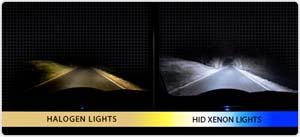 |
High
Intensity Discharge head lamp conversions: a Bright idea?
|
|
This page contains: |
Introduction | To fit or not to fit | Panacea? | Blinding solution | Type approval | Legality | Insurance | Conclusions | Further Reading |
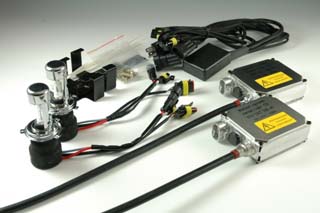 High
Intensity Discharge (HID) bulbs (Wikipedia
link: what are HIDs?) are becoming increasingly common place as
Original Equipment on new cars – and their advantages over more conventional
incandescent bulbs (high light output, low heat generation, low energy
consumption) explain their attractiveness to car manufacturers. Like automotive
moths, the aftermarket has been highly attracted to these bulbs, and their
desirability has lead to the ready availability of HID bulbs as direct
replacement to a wide range of standard bulb fitments (H1, H4, H7 amongst
others).
High
Intensity Discharge (HID) bulbs (Wikipedia
link: what are HIDs?) are becoming increasingly common place as
Original Equipment on new cars – and their advantages over more conventional
incandescent bulbs (high light output, low heat generation, low energy
consumption) explain their attractiveness to car manufacturers. Like automotive
moths, the aftermarket has been highly attracted to these bulbs, and their
desirability has lead to the ready availability of HID bulbs as direct
replacement to a wide range of standard bulb fitments (H1, H4, H7 amongst
others).
To fit or not to fit, that is the question
Just because they are available does it mean we should all be fitting them?
Certainly there are a number of compelling advantages when it comes to fitting these bulbs to MGFs and perhaps too to MG TFs. MGFs in particular are renowned for their poor head lamps, especially the dipped beam. Fitting brighter than standard replacement bulbs is widespread, although fitting bulbs more powerful than standard 55/60W fare is technically illegal under UK law. Not that this is a problem for HID bulbs which generate significantly greater quantities of light for any given power rating (with many kits rated at just 35W).
Fitting a brighter bulb overcomes some of the deficiencies of the standard head lamp set up, which in a significant part is mediated by degeneration and oxidation of the reflective metalised coating of the plastic headlamp bowl. Heat from the standard bulb is thought to be at least partially responsible for this deterioration – so perhaps the cooler running HID bulb may help to slow this process?
So the brighter, lower energy consuming and cooler running HID bulb should be the answer to all MGF owner’s poor headlamp performance problems?
HIDs: panacea of all MGF lighting problems?
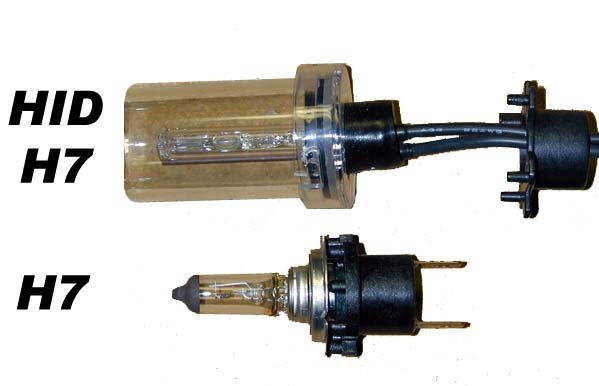 Unfortunately,
as perhaps you might predict, the answer is rather more complicated than that.
Unfortunately,
as perhaps you might predict, the answer is rather more complicated than that.
The main problem is that the standard, original headlamp reflector is designed around an incandescent filament bulb. When you compare a HID H7 with a halogen H7 for example, the difference in length is immediately apparent (see picture right - the HID H7 is shown in its protective storage case which is removed on installation, but the bulb within is clearly 50% longer than the conventional H7 bulb shown below it).
So what you may wonder?
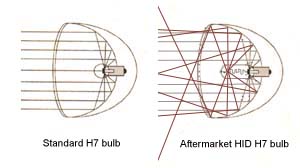 The
problem is the focal point of the bulb. The reflector is a parabolic mirror,
whose point of focus resides the standard headlamp bulb (see figure left). A HID
bulb’s light is not made at the same point as the filament bulb – which means
that the parabolic mirror is not channelling the emitted light as a parallel
beam of light, but one that is potentially widely scattered. Poorly focused
light like this will project well beyond the designed beam dispersal pattern,
potentially causing glare and dazzling on-coming traffic.
The
problem is the focal point of the bulb. The reflector is a parabolic mirror,
whose point of focus resides the standard headlamp bulb (see figure left). A HID
bulb’s light is not made at the same point as the filament bulb – which means
that the parabolic mirror is not channelling the emitted light as a parallel
beam of light, but one that is potentially widely scattered. Poorly focused
light like this will project well beyond the designed beam dispersal pattern,
potentially causing glare and dazzling on-coming traffic.
A blinding solution
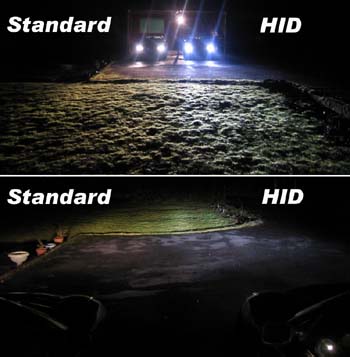 Unfortunately,
on an MGF, it isn’t so much of a question of whether if this happens, it does.
That many find that the main beam is superfluous once HID bulbs have been fitted
to the dipped beam is perhaps some clue to this – over and above the increased
brightness of the bulb (MGFR
forum discussion - Charles' HID conversion in comparison to a good standard
bulb set up is shown opposite, right).
Unfortunately,
on an MGF, it isn’t so much of a question of whether if this happens, it does.
That many find that the main beam is superfluous once HID bulbs have been fitted
to the dipped beam is perhaps some clue to this – over and above the increased
brightness of the bulb (MGFR
forum discussion - Charles' HID conversion in comparison to a good standard
bulb set up is shown opposite, right).
Whether this is enough extraneous light glare to upset your fellow road users is another question, but to properly apply this technology to an MGF (or TF) would require the employment of a correct parabolic mirror – and the easiest way to do this is the installation of a projector lens system in place of the dipped beam’s standard reflector, which has been designed from the outset to use HID bulbs.
For other cars, this can be a simple case of using the projectors from another car in the range that employed these bulbs as standard (useful to know if you own an MG ZT for example), but this route is not available to F and TF owners.
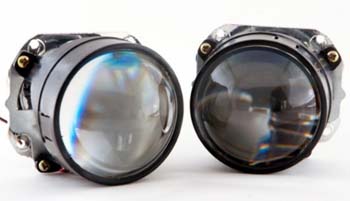 An
alternative is to use an aftermarket projector (many kits available from China -
MGR.org/ZR forum
discussion
bi-xenon projector link) and a bit of ingenuity.
An
alternative is to use an aftermarket projector (many kits available from China -
MGR.org/ZR forum
discussion
bi-xenon projector link) and a bit of ingenuity.
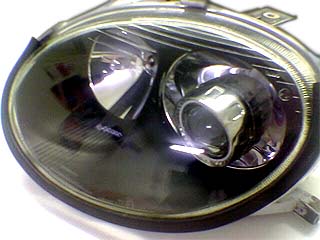
Type approval and E-marking
However, even this is not going to be ideal; two seater MGs were never type approved with these kits, most Chinese kits are not "E" marked, and MGF/TF were never fitted with self-levelling suspension or headlamp washers. All of these mean that HIDs can never really be considered a 'legal' retrofit.
Self-levelling is perhaps not entirely essential – after all, we’re talking about a 2-seater sports car, so is unlikely to carry anything so heavy as to alter the pitch of the vehicle as to cause glare to oncoming vehicles. But the type approval regulations do not take this into consideration, and self levelling is unfortunately a requirement. Headlamp washers on the other hand ought to be pretty easy to sort out by a dedicated DIYer using suitable parts from a donor vehicle.
Legality of HIDs
The department for transport in the UK are quite clear in their interpretation of the rules applying to HID after-market conversions (Department for Transport website - essentially ALL HID equipped cars are permitted within a loop hole of the Road Traffic act so long as they were type-approved within the EU, and yet retrofitment is not specifically outlawed), but conversion enthusiasts will always point out that their car always passes an MoT without problem.
However, there is a big difference over what is acceptable for manufacturers to sell on a new vehicle in terms of type approval, and what is acceptable to the MoT man come that annual inspection. In fact there is a huge difference.
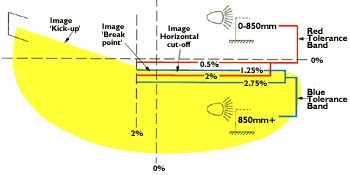 In
the UK, there are no checks on vehicles that they remain type approved, unlike
the system in operation in some other EU countries. Which means that at present,
MoT testers do not check to see whether a car that has a HID conversion has got
type approval for its use, and has the necessary hardware (headlamp
washers/suspension levelling). The MoT man is only concerned about beam pattern
(pictured, right), and whether your headlights are adequately bright. HID bulbs
will certainly be sufficiently bright (MoT man doesn’t check to ensure that they
are not too bright), and so long as there is a reasonable dispersal pattern
within the test area on the headlamp test, you should be fine. There is a
substantial tolerance here – which is why degenerating MGF headlamp reflectors
only become MoT failures when they’re almost completely non-reflective.
In
the UK, there are no checks on vehicles that they remain type approved, unlike
the system in operation in some other EU countries. Which means that at present,
MoT testers do not check to see whether a car that has a HID conversion has got
type approval for its use, and has the necessary hardware (headlamp
washers/suspension levelling). The MoT man is only concerned about beam pattern
(pictured, right), and whether your headlights are adequately bright. HID bulbs
will certainly be sufficiently bright (MoT man doesn’t check to ensure that they
are not too bright), and so long as there is a reasonable dispersal pattern
within the test area on the headlamp test, you should be fine. There is a
substantial tolerance here – which is why degenerating MGF headlamp reflectors
only become MoT failures when they’re almost completely non-reflective.
Essentially, as I write this article (January 2011), a HID equipped MGF will pass an MoT (at least until the MoT regulations are tightened up).
Insurance declarations
The next hurdle is your insurance company. Perhaps surprisingly, insurance companies appear to be sanguine about the retrofitment of HIDs at the moment. If the modifications are declared and accepted by the insurer, there should be no problem; the insurer has accepted the risk liability of the modification. However, should you have an accident where your headlights were thought to be a significant contributory factor, there could be problems if the modification were not declared, and you, the owner, would be completely liable to all damages, third party included. And if you were involved in an incident where head light dazzle were deemed a major contributory factor, then there is a strong potential that Road Traffic/ Highway Code offence charges could be raised against you. Not good.
HIDs are not technically legal as a retrofit, but they will currently pass an MoT inspection. There are definite advantages with respect to light power and lower heat generation, but getting a good light beam pattern may require the use of a dedicated projector unit, pushing up both cost and difficulty of the installation. After having given the topic a great deal of thought, I have not gone down this route. But then I live in a city with widespread street lighting, so the performance of the dipped beam is rather less important than if I lived in the countryside. Whether you should fit these bulbs has to be your decision, but my opinion is to edge against it.
References and further reading:
- What are HIDs? http://en.wikipedia.org/wiki/High-intensity_discharge_lamp
- Visual glare from HIDs: http://www.ncbi.nlm.nih.gov/pmc/articles/PMC1771460/
- Sharky's step by step guide on Rover-Org: http://forums.mg-rover.org/showthread.php?t=215232&highlight=hid
- Department for Transport's interpretation of the Road Traffic Act pertaining to HIDs: http://www.dft.gov.uk/pgr/roadsafety/drs/hidheadlamps
- A summary of HID lighting and retrofitment: http://www.danielsternlighting.com/tech/bulbs/Hid/conversions/conversions.html